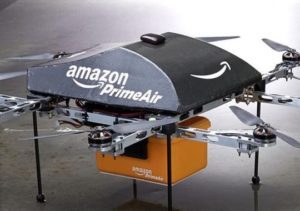
Amazon may have the answer with a pending patent for “sense and avoid for automated vehicles,” technology. The patent application explains how Amazon’s drones would use laser, sonar and other technologies to plan routes and avoid obstacles.
While Amazon, like other retailers, seems to be in a race to develop potentially money saving drone delivery technology, Amazon’s leadership seems to recognize that a lack of safety measures could kill the industry before it starts. “While there are many beneficial uses of these vehicles, they also have many drawbacks,” the patent states. “For example, UAVs require involvement to ensure that the vehicles do not collide with other UAVs or other objects.”
Amazon declines to comment on the company’s drone patents.
The Amazon patent is simply one of the latest “sense and avoid” technologies to be made public, which would seem to indicate that the technology is a real possibility. NASA and the FAA have been testing PrecisionHawk’s products, including the low-altitude avoidance tracking and avoidance systems introduced last January; and an MIT researcher has developed a bird-like drone that can avoid obstacles at high speeds.
While the geo-fencing technology for keeping drones away from airports and public buildings is readily available, traffic control systems are deep in development, and “sense and avoid” technology seems to be a reality, regulations lag behind, limiting the possibility of drone delivery and other commercial applications. Regardless of technology, regulations still stipulate that drones cannot be flown out of the line of sight of the operator, over 400 feet in altitude, or near people.
Miriam McNabb is the Editor-in-Chief of DRONELIFE and CEO of JobForDrones, a professional drone services marketplace, and a fascinated observer of the emerging drone industry and the regulatory environment for drones. Miriam has penned over 3,000 articles focused on the commercial drone space and is an international speaker and recognized figure in the industry. Miriam has a degree from the University of Chicago and over 20 years of experience in high tech sales and marketing for new technologies.
For drone industry consulting or writing, Email Miriam.
TWITTER:@spaldingbarker
Subscribe to DroneLife here.